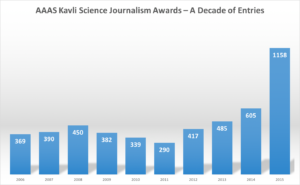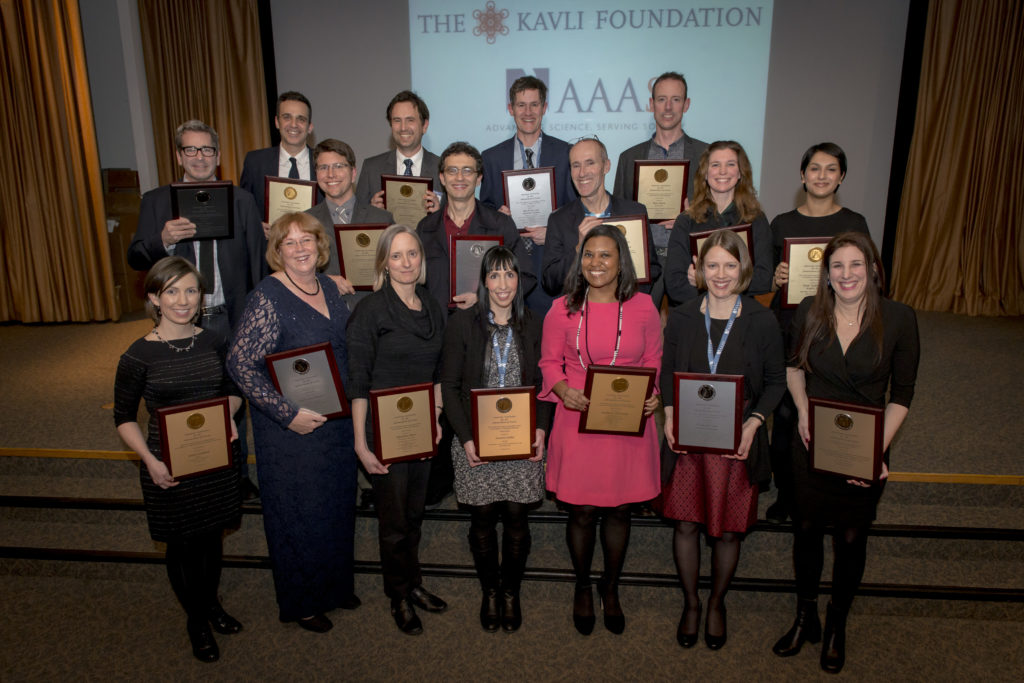An Awards Program Goes Global
When the American Association for the Advancement of Science (AAAS) announced a worldwide expansion of the AAAS Kavli Science Journalism Awards last year, it recognized the increasingly global nature of the science journalism community and triggered a challenging effort to retool the historic awards program on the fly.
But the scramble was well worth the effort. Just under 40 percent of the 2015 awards went to international recipients, a number comparable to the percentage of international entries submitted. The AAAS Kavli awards now truly recognize the impact of science, and science journalism, around the world.

Gentle prodding
The first steps toward the international move began about 15 years ago with some gentle prodding by a group of leading international reporters—from New Scientist, The Economist, Nature and The Guardian—who had been urging an expansion of the program. They wanted the award to include international journalists working in the United States for publications headquartered abroad. They argued that journalists who pay U.S. taxes and write for publications printed or distributed in the United States should be eligible for the award, no matter where their home offices happen to be.
As it happened, a decision by The Kavli Foundation in 2009 to endow the awards program would soon open even wider horizons. A $2.3 million gift from the foundation assured the future of the program (which had been established in 1945) and created a new partnership between AAAS and The Kavli Foundation that would allow the awards to make the long-sought-after international jump. Both organizations shared an international outlook and an appreciation of the importance of quality journalism in helping societies—all societies—better understand science as a global enterprise.
So in the summer of 2014, AAAS Chief Communications Officer Ginger Pinholster contacted James Cohen, director of communications and public outreach at The Kavli Foundation, to propose an ambitious expansion of the program well beyond the borders of the United States. Journalists worldwide were soon to be eligible in all award categories. (The award for reporting on science news for children always had been open to all.)
After months of discussion on how to structure an expanded program, with guidance from the leadership of both organizations, the foundation agreed to double the award’s endowment in order to extend eligibility to journalists worldwide. With the prospect of significantly more submissions, the new endowment also doubled the number of awards in each category and increased their value. We now offer a Gold Award worth $5,000 and a Silver Award worth $3,500 in each category.
“Like scientific discovery, excellent science journalism can happen anywhere in the world,” said current AAAS CEO Rush Holt in the announcement of the expansion on May 5, 2015. “By recognizing the world’s best science news reporting, AAAS and The Kavli Foundation are working to build a culture of respect for the value of science journalism to society, while promoting public understanding of science more broadly.”
A tidal wave
Since we usually begin soliciting entries for the contest in early May, the timing of the announcement was daunting. We quickly updated the eligibility guidelines, contest rules, and award descriptions. We also began an aggressive effort to solicit entries from abroad, including contacting 51 member groups associated with the World Federation of Science Journalists. We sent a series of emails to more than 6,000 reporters who were registered with the EurekAlert! service of AAAS.

We expected a surge of entries in the weeks following the announcement. And it was, in fact, a tidal wave. By the August 1 submission deadline, we had received more than 1,100 entries from 44 countries, nearly twice as many entries as the year before. About 40 percent of them were from journalists working for international outlets. (We required English translations for pieces done in languages other than English, but offered limited translation services to entrants for whom providing a translation would be a hardship.)
We called on veteran judges and members of the Managing Committee—all of them senior science journalists—to help winnow the huge number of entries prior to submitting them to review for scientific accuracy by the Washington-area scientists who volunteer to help out. We boosted the number of these screeners (to nearly 70 in all) and also recruited international judges with ties to international outlets—two from The Guardian, one from Nature and one from Deutsche Presse-Agentur, the German news agency—for the independent judging panels.
AAAS Entry Deadline Aug. 1st |
| AAAS and The Kavli Foundation expect to continue building the program as a platform for both honoring and supporting science journalism. The 2016 competition is now under way, with an entry deadline of August 1st. For more details and to enter, go to our newly expanded website. There you will also find stories and videos about the awards program and a complete list of recipients. Follow us on Twitter: @AAASKavli. |
One year down
In the end, the inaugural year of the contest was both hectic and gratifying. We had winners from the BBC, Le Monde, Nature, Neue Zürcher Zeitung, and the Danish Broadcasting Corporation. The international recipients were enthusiastic about the awards, and their presence added a new dimension to the awards ceremony and other activities held in conjunction with the AAAS Annual Meeting, including a luncheon roundtable in which the winners discussed their award-winning work and current issues in science journalism.
Rami Tzabar of the BBC, a co-winner of the Gold Award in the radio category, wrote on Twitter that winning the contest and accepting his award “was a great experience and I urge anyone eligible from around the world to enter!”
Much work remains as we seek to increase the number and quality of international entries, diversify the screening and judging panels, and broaden the impact of the awards through an enhanced website and speaking and mentoring opportunities for our growing cadre of award winners. But the core values of the AAAS Kavli awards program will remain the same: honoring distinguished science reporting by professional journalists for a general audience; and selection of the winners by independent panels of science journalists.
| Earl Lane is executive director of the AAAS Kavli Science Journalism Awards and has administered the program since 2005, when he joined AAAS as a senior communications officer. Previously, he was for many years a science writer in the Washington bureau of Newsday and shared a 1991 AAAS Science Journalism Award for a Newsday series on “The Genetic Frontier.” |

